Those just picking up guitar often wonder: What is a fret on guitar? what’s their purpose, and how do they relate to the fretboard?
Guitar frets are thin metal strips embedded along the neck of a guitar, forming an integral part of the instrument’s design & function. These raised bars divide the fingerboard into precise intervals, each representing a semitone in the musical scale.
When a string is pressed against a fret, it effectively shortens the vibrating length of the string, producing a specific pitch. This system allows guitarists to play accurate notes and chords without the need for perfect finger placement, as would be required on fretless instruments.
Frets not only aid in pitch accuracy but also contribute to the guitar’s distinctive sound and playability, making them crucial elements in both the visual and functional aspects of the instrument.
Key Takeaways:
- Guitar frets are metal strips on the fingerboard that divide the neck into semitones, allowing guitarists to play accurate pitches by pressing strings against them.
- The number of frets varies by guitar type, with classical guitars typically having 19, acoustics often 20, and electrics commonly 21 to 24 frets.
- Proper fretting technique involves pressing the strings with fingertips just above the fret, using enough pressure for a clear note without straining.
- Fret size and material affect tone and playability, with wider and taller frets often preferred by rock guitarists, and most frets made from a copper-nickel alloy.
- Fret buzz, a common issue caused by wear or poor setup, can usually be resolved through regular maintenance and proper adjustment.
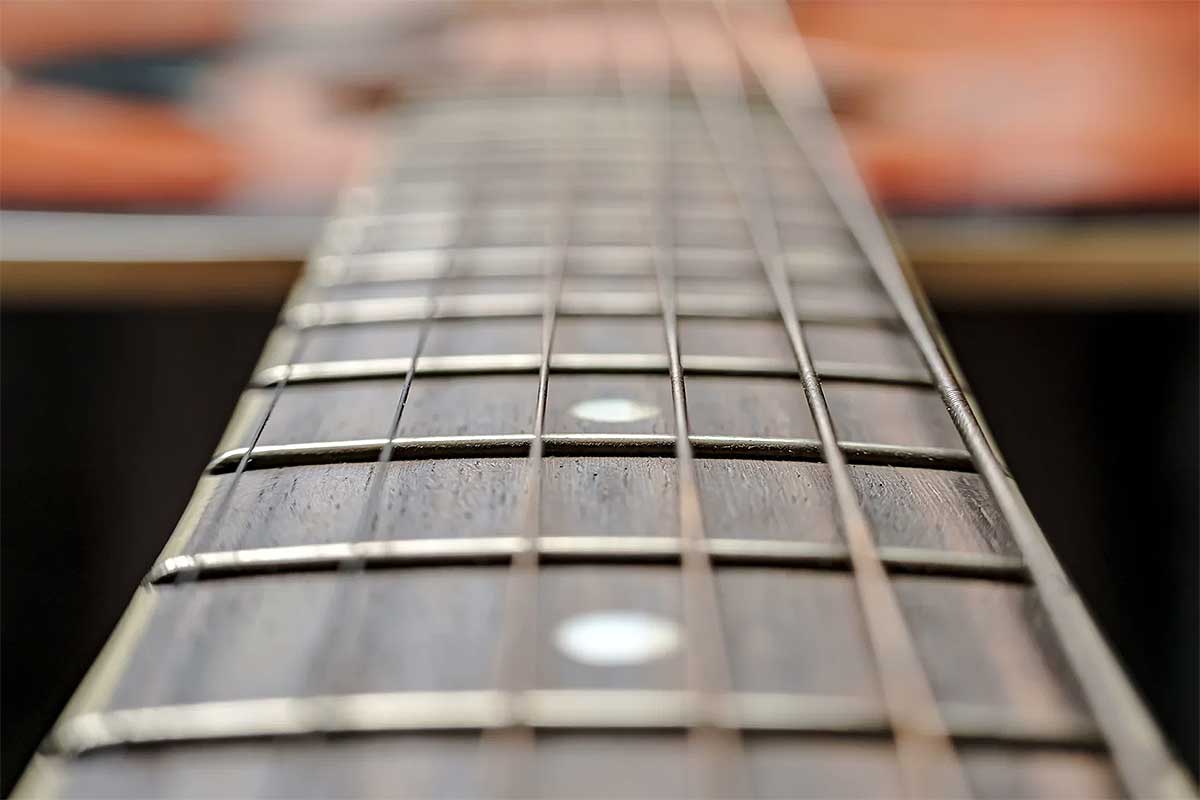
Related: Who was the inventor of electric guitar
What is a Guitar Fret In-Depth
A guitar fret is more than just a metal strip; it’s a precisely calculated and positioned element that fundamentally shapes the instrument’s playability and sound.
Frets are typically made from hardened nickel-silver alloy and are carefully inserted into slots cut into the fingerboard. Their height and width are crucial, affecting both tone and playability. Taller frets allow for easier string bending and vibrato, while wider frets can enhance sustain.
The positioning of frets follows a mathematical principle known as the “Rule of 18,” which ensures that each fret represents exactly one semitone in the musical scale. This precise spacing is critical for maintaining proper intonation across the entire neck.
Frets also serve as wear points, protecting the more valuable fingerboard wood from damage caused by string friction. Over time, frets may wear down and require replacement or “dressing” to maintain optimal performance.
Understanding fret function and care is essential for guitarists, as these small metal strips play a significant role in defining an instrument’s character and feel.
Related: The full anatomy of an electric guitar
What Are Semitones & How Do They Relate
Semitones, also known as half steps, are the smallest interval between two notes in Western music. On a guitar, each fret represents one semitone.
The fretboard layout allows for easy visualization of these intervals: moving up one fret always raises the pitch by one semitone. For instance, on the low E string, pressing the first fret produces an F, the second fret F#, and so on.
This consistent semitone progression applies to all strings across the fretboard. Understanding semitones is crucial for guitarists as it forms the basis for guitar scales, chords, and intervals.
The guitar’s unique design, with its vertical and horizontal note relationships, allows players to easily grasp musical theory concepts like fourths and fifths by visualizing patterns on the fretboard. This layout makes the guitar an excellent instrument for learning music theory practically.
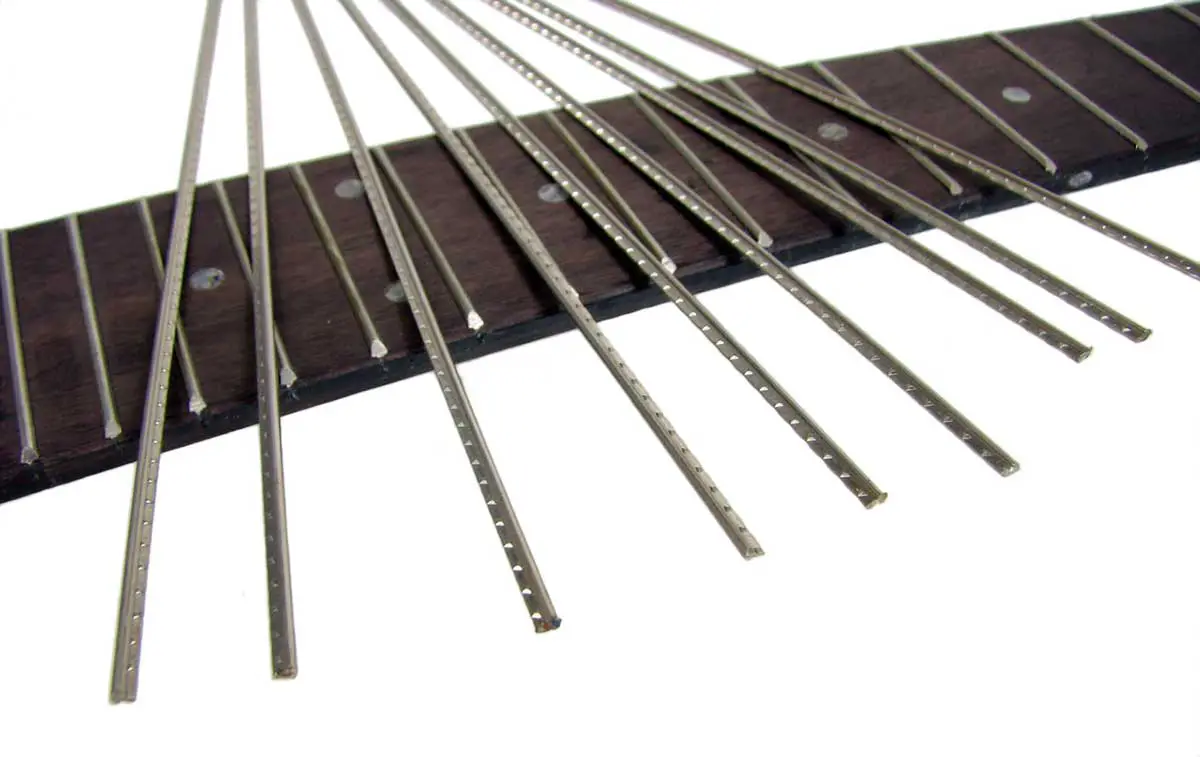
How To Properly Use Frets
- Finger Placement:
- Press the string just behind the fret, not on top of it.
- Use the tips of your fingers, not the pads.
- Apply enough pressure to produce a clear sound, but don’t squeeze too hard.
- Hand Posture:
- Keep your wrist slightly curved, not flat or sharply bent.
- Position your thumb behind the neck for support.
- Allow space between your palm and the neck.
- Practice Techniques:
- Start with single notes, then progress to chords.
- Practice transitioning between frets smoothly.
- Use a metronome to develop consistent timing.
- Common Mistakes to Avoid:
- Pressing too far from the fret (causes buzzing).
- Using too much force (leads to hand fatigue).
- Letting unused fingers touch other strings (mutes sound).
- Maintenance Tips:
- Keep fingernails on your fretting hand short.
- Build calluses gradually through regular practice.
- If you experience pain, adjust your technique or take a break.
- Listening Skills:
- Pay attention to the clarity of each note.
- Listen for unwanted buzzing or muted strings.
- Compare the sound of properly fretted notes to open strings.
Remember, developing proper fretting technique takes time and practice. Be patient with yourself and focus on producing clear, resonant notes. With consistent practice, proper fretting will become second nature.
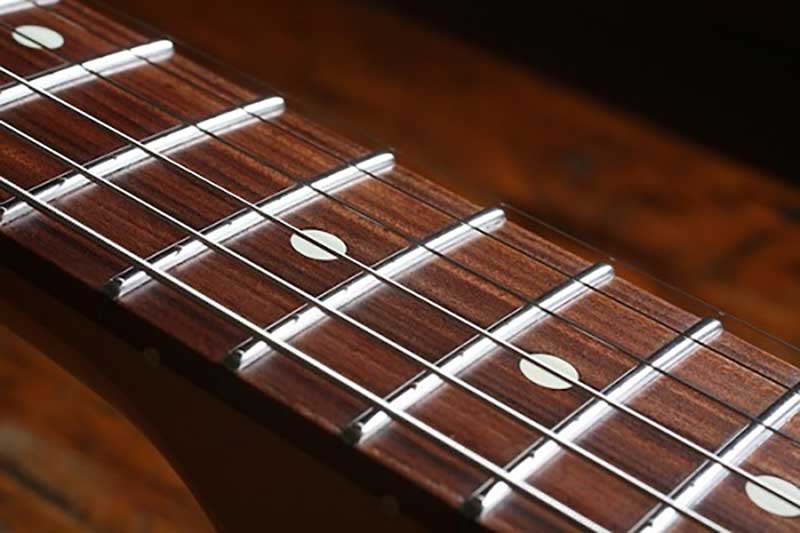
What is Fret Buzz? Cause & Solution
Fret buzz is an unwanted rattling sound that occurs when a string vibrates against a fret. It’s a common issue for both beginners and experienced guitarists, often resulting from various factors:
- Worn frets: Over time, frets can wear down, causing uneven surfaces.
- Poor setup: Incorrect neck relief, action height, or nut slot depth can lead to buzzing.
- Playing technique: Pressing too lightly or too hard on the strings can cause buzz.
- Manufacturing issues: In rare cases, poor craftsmanship can be the culprit.
Solutions:
- Adjust string action (height) at the bridge
- Check and adjust neck relief (truss rod)
- Have a professional level the frets
- Improve playing technique by finding the right pressure
- Practice proper muting techniques to prevent unwanted string vibrations
While some minor adjustments can be made at home, significant fret buzz issues often require professional setup. Regular maintenance and proper playing technique can help prevent most fret buzz problems, ensuring a clearer, more pleasant guitar sound.
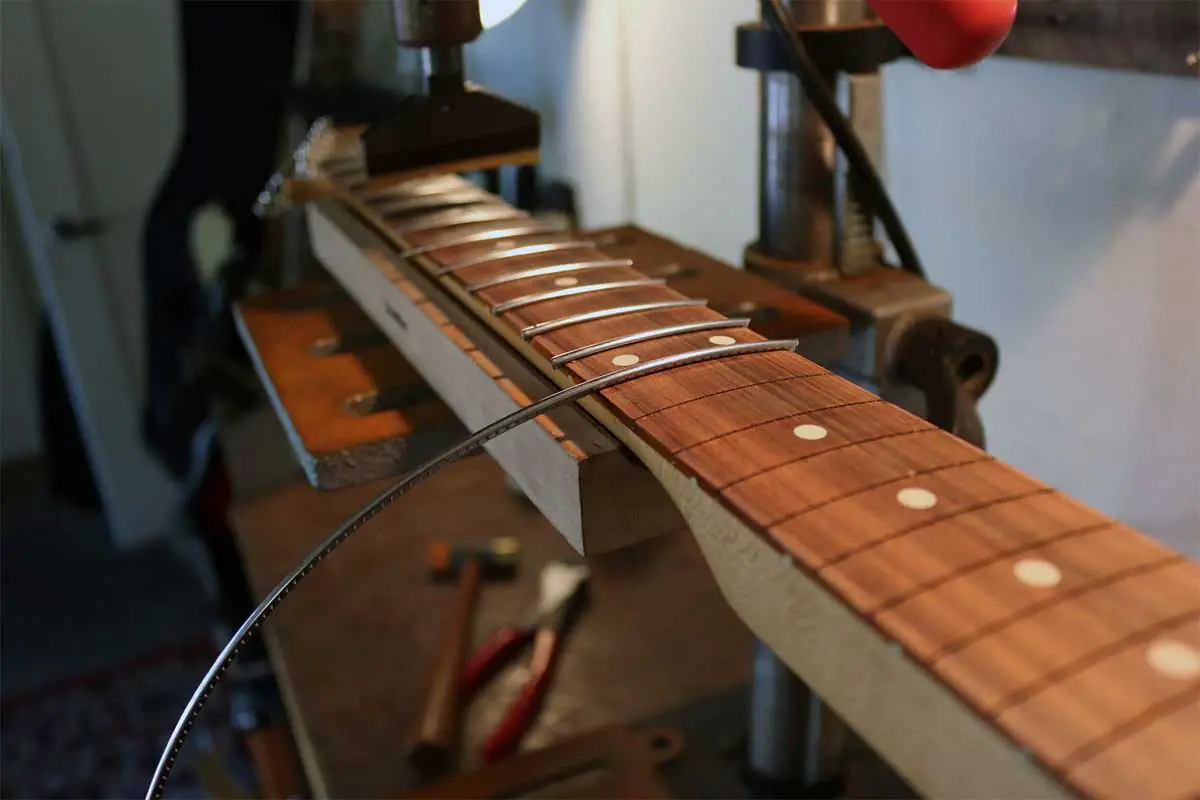
How Many Frets Does A Guitar Have
The number of frets on a guitar can vary depending on the type and model of the instrument. Generally, most guitars have between 19 and 24 frets, but this can differ based on the guitar’s design and intended use.
How Many Frets on Electric Guitars
Electric guitars typically have more frets than their acoustic counterparts due to their design and playing style requirements. Most electric guitars feature:
- 21 frets: Common on many Fender models like the standard Stratocaster
- 22 frets: Found on numerous guitars across various brands
- 24 frets: Popular for lead guitarists, offering two full octaves on each string
Some modern electric guitars, particularly those designed for metal or shred styles, may even have 27 or more frets. The extra frets allow for extended range and higher notes, especially useful for solos and complex lead work.
How Many Frets on Acoustic Guitars
Acoustic guitars generally have fewer frets than electric guitars, partly due to their body shape and construction. Common fret counts for acoustic guitars include:
- 18 frets: Found on some classical guitars
- 19 frets: Typical for many traditional acoustic guitars
- 20 frets: Common on modern acoustic guitars, with 14 frets clear of the body
Some acoustic guitars feature a cutaway design, which allows easier access to higher frets. These models might have up to 22 frets, though this is less common.
The reduced fret count on acoustics is often due to the neck joining the body at a lower fret, usually around the 12th or 14th fret, to maintain optimal resonance and projection.
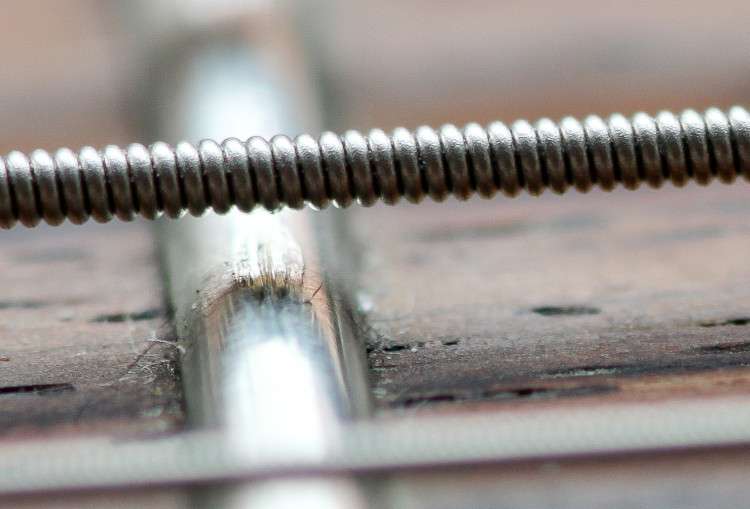
Guitar Fret Sizes & Their Impact
Fret size plays a crucial role in a guitar’s playability, tone, and overall feel. The two main aspects of fret size are height and width, collectively known as the “crown.”
Taller frets:
- Facilitate easier string bending and vibrato
- Require less pressure to fret notes
- Can make the guitar feel more responsive
Wider frets:
- Provide more surface area for finger contact
- Can enhance sustain and tone clarity
- Offer a smoother feel when sliding
Jumbo frets (tall and wide) are popular among rock and metal guitarists for their ease of playability and enhanced sustain. They allow for easier string bending and can contribute to a brighter tone. Conversely, vintage-style narrow frets offer a more traditional feel and often produce a warmer tone.
Medium frets strike a balance between playability and traditional feel, making them a popular choice for many guitarists across various genres.
Ultimately, fret size preference is subjective & depends on playing style, genre, and personal comfort. Many guitarists experiment with different fret sizes to find their ideal setup, considering factors such as hand size, playing technique, and desired tone.
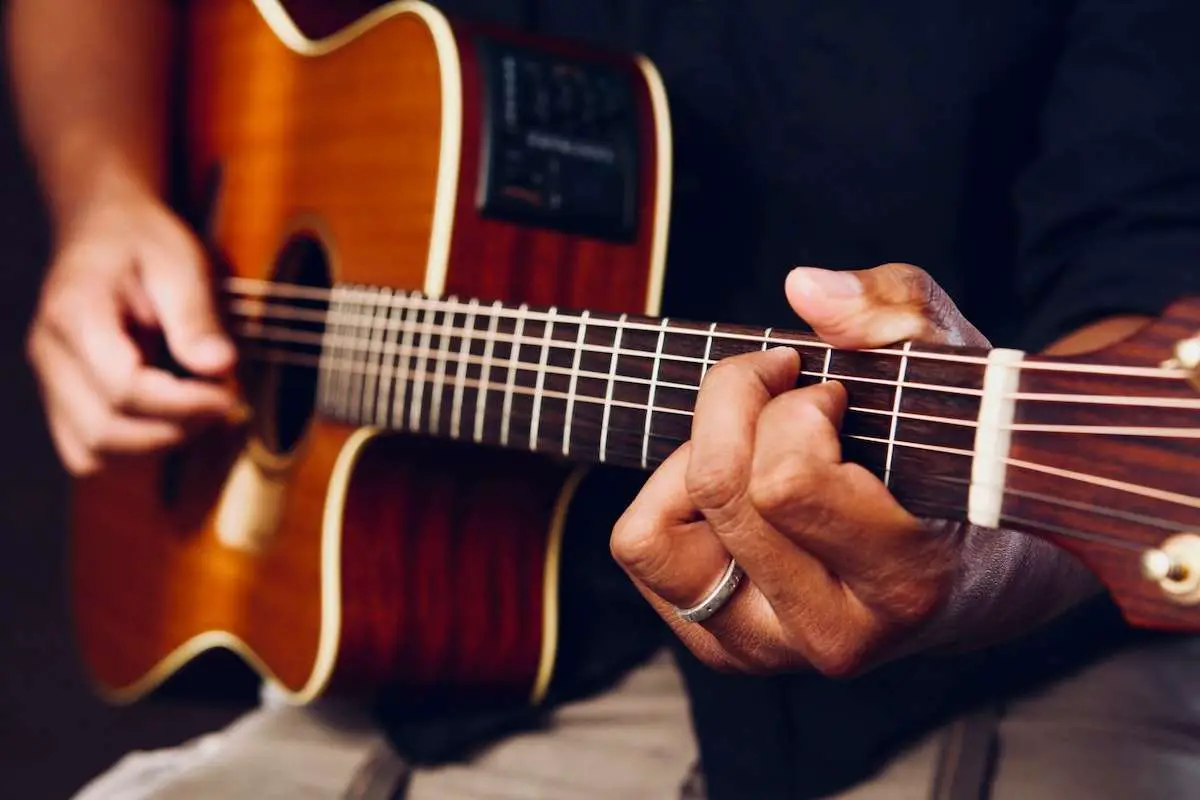
Fret Materials: Composition & Characteristics
Guitar frets are typically made from three main materials:
- Nickel Silver (most common):
- Composed of 80% copper, 18% nickel, and 2% zinc
- Offers a balance of durability and workability
- Produces a warm tone
- Prone to wear over time
- Stainless Steel:
- Extremely durable and resistant to wear
- Produces a brighter tone
- Harder to work with during installation and maintenance
- More expensive than nickel silver
- Brass (less common):
- Softer than nickel silver or stainless steel
- Wears down quickly but easy to replace
- Can impart a unique tonal quality
Each material has its pros and cons, affecting tone, durability, and maintenance requirements. The choice of fret material can significantly impact a guitar’s playability, longevity, and sound characteristics. Guitarists often choose based on their playing style, maintenance preferences, and tonal goals.
Related: Guitar Tuning In Hz
Conclusion
Guitar frets, though seemingly simple metal strips, are a fundamental component that shapes the instrument’s playability, sound, and overall character. They represent the intersection of music theory, engineering, and craftsmanship in guitar design. From their precise mathematical placement to the variety in materials and sizes, frets embody the evolution of the guitar as an instrument.
Understanding frets goes beyond mere technical knowledge; it’s about appreciating how these small elements contribute to the guitar’s versatility and accessibility. They allow beginners to produce accurate notes easily while providing advanced players with the tools for complex techniques and expressions.
The ongoing debates about fret sizes, materials, and counts reflect the guitar’s adaptability to different musical styles and player preferences. As guitar technology continues to evolve, frets remain a crucial area of innovation, balancing tradition with modern playing demands.
Ultimately, frets are not just physical components but a bridge between the player’s intent and the instrument’s voice, playing a vital role in the creation and evolution of music across genres & generations.
